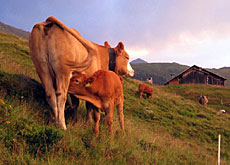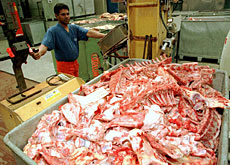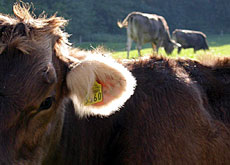Mad cow disease no longer a priority

The Federal Veterinary Office says it will reduce its BSE unit from 20 people to 12 by the end of 2006 and shift its focus to the entire food production chain.
The unit, which was created in 2001 to deal exclusively with mad cow disease, will in future concentrate on animal health and protection, humane production, food safety and hygiene.
The bovine spongiform encephalopathy (BSE) unit’s budget will also be reduced by over a third, from SFr3.5 million ($2.8 million) to SFr2 million.
So far this year two cases of BSE have been reported; in 2005 the Swiss authorities reported three cases of the encephalopathy in animals that were infected in the mid-1990s.
The crisis over mad cow disease peaked in Switzerland in 1995 when 68 cases were reported across the country.
The infection was found to spread through the use of meat and bone meal to feed cattle. This was banned in 1990 as one of the first measures implemented by the Swiss authorities, but it took years before it completely disappeared from farms.
It was only in 2004 that no traces of banned animal products were found in feed for livestock for the first time. In 2003 0.3 per cent of tests still revealed traces.
Model nation
In 1990 Switzerland became the third European country after Britain and Ireland to register cases of BSE in its cattle. The disease was first defined in Britain in November 1986. Some 83,000 cases have been detected there since then.
The human illness, Variant Creutzfeldt-Jakob Disease (vCJD), was recognised in 1996 and is thought to result from the consumption of BSE-infected meat. There have been no cases of vCJD reported in Switzerland.
In 2004, the United Nations praised Switzerland for its efforts to control mad cow disease, calling it a model for other nations.
The same year, Swiss experts were sent to the United States, following that country’s first confirmed case of BSE.
swissinfo with agencies
The first case of bovine spongiform encephalopathy (BSE), or mad cow disease, was reported in Britain in 1986.
In 1990 Switzerland became the third European country after Britain and Ireland to register cases of BSE, which progressively destroys the brain and nervous system.
Switzerland quickly adopted measures to limit the spread of BSE: a complete ban on animal products in feed for livestock; the elimination of the herd where cases of BSE were confirmed, and the incineration of the carcasses of sick animals.
The human form of BSE, new Variant Creutzfeldt-Jakob disease (vCJD) was discovered in 1996.
The first case of BSE discovered in Britain in 1986.
Disease appears in Swiss cows for first time in 1990.
Federal Veterinary Office introduces fast BSE test in 1999 to monitor cattle.
In 2001, the office slaps complete ban on meat and bone meal in feed for livestock.

In compliance with the JTI standards
More: SWI swissinfo.ch certified by the Journalism Trust Initiative



You can find an overview of ongoing debates with our journalists here. Please join us!
If you want to start a conversation about a topic raised in this article or want to report factual errors, email us at english@swissinfo.ch.